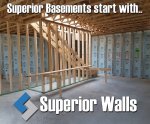I'm building my basement and the foundation walls are Superior Walls. They are precast walls with built in 2" Styrofoam R12 insulation.
The walls are ready for sheetrock. I am considering adding additional foam or fiberglass insulation behind the sheetrock for sound deadening properties. The additional insulation would sit against the built in Styrofoam.
Would adding additional insulation make any difference in sound dampening characteristics in the basement?
If I install the sheetrock without additional insulation there would be a 6" gap between the Styrofoam and the sheetrock.
The basement will be a home recording studio / music room.
Here's what Superior Walls looks like:

The walls are ready for sheetrock. I am considering adding additional foam or fiberglass insulation behind the sheetrock for sound deadening properties. The additional insulation would sit against the built in Styrofoam.
Would adding additional insulation make any difference in sound dampening characteristics in the basement?
If I install the sheetrock without additional insulation there would be a 6" gap between the Styrofoam and the sheetrock.
The basement will be a home recording studio / music room.
Here's what Superior Walls looks like:


